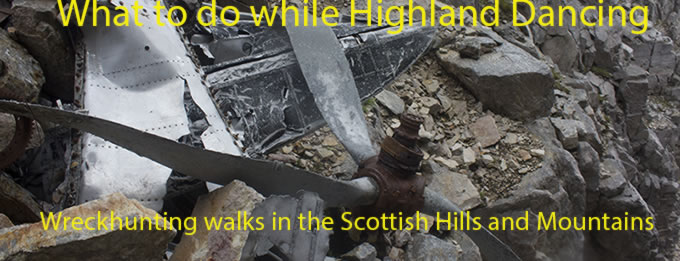The Souvenir
Avro Vulcan XH477 on Hill of St Colm.
(distance covered
= 9.0 mile/Ascent =+696m)
The Championships at Aberdeen are usually very long days, this meant I had numerous options for filling my day in including another attempt at reaching the DH Mosquito up the top of Glen Esk.
Including the one in Glen Esk I had narrowed my choices down to six possible crash sites to visit, the others being: A Miles Master on Hill of Fingray, A B-24, Beaufort and Sea Fury on Hill of Wirren and an F100 Super Sabre on Peter Hill. I couldn't make my mind up which to go for so I printed off maps for all of them with the intention of deciding once we were up at Aberdeen. The night before we left I realised that Hill of St Colm, where an Avro Vulcan crashed, could be accessed from the same Glen as Peter Hill. I made my mind up to try and do both of those.
Parked at a small car park at the end of the
metalled road running from Finzean to Birse Castle.
There was a car park marked on the o/s map about 1 mile short of Birse Castle, there were no signs of any sort prohibiting public vehicles from continuing right up to the castle but as the metalled single lane road became a dirt track after the carpark, and because the Forest of Birse estate had built a car park here, it suggested this was the place to leave the car!
Heading off down the dirt track, The Vulcan
crash site
location is arrowed on the bealach between Gannoch and Hill of St Colm.
I'd worked out the distance to the Vulcan crash site and back was going to be roughly 8 to 9 mile, so I should be easily able to complete that then move the car back down the glen a bit to tackle Peter Hill which would only involve about a 3 mile round trip to visit the F-100.
View south over Auchabrack Farm; the Fungle Road path heads off that way over to Glen Esk.
The weather forecast had not been good for this day and snow had been mentioned, but as I was walking down the dirt track towards Birse Castle the sun was shining and this combined with the sound of the lambs bleating and the birds singing made it one of those 'can't get better than this' moments.
Entering the Castle grounds.
I am normally a bit apprehensive about walking through farmyards or the grounds of Stately homes etc. but as I was approaching Birse Castle I was passed by a couple of vehicles and all I received was a friendly wave so I continued quite happily straight through the castle grounds.
Approaching the Castle.
I decided straight away on seeing Birse Castle that if I ever win the lottery then this is where I would like to live. The Castle was restored in the early twentieth century from a ruin.
Birse Castle
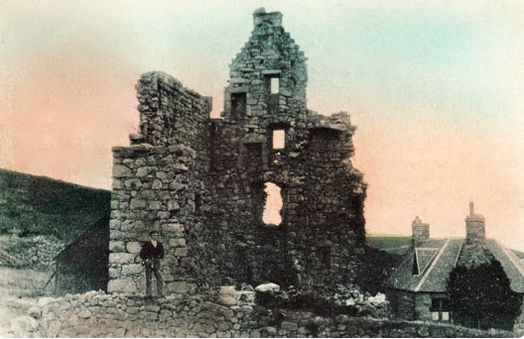
1904, before it was restored/Rebuilt.
This end incorporates the original structure.
This end was added at a later date.
Passing the castle with Gannoch and Hill of
St Colm dead ahead.
above and below:-Leaving the castle grounds
Once through the Castle grounds and over the Burn of Corn the hard work began as the Landrover track became increasingly steeper as it made its way up the northern flank of Gannoch. A sign warning 4x4's to select their very lowest gear heralded a particular steep section which made me think I had made the right decision in not fetching the bike, as pushing it up here would have been incredibly hard work and riding it down again I would have been straight over the handlebars at the slightest sniff of touching the brake levers.
Dropping down to the Burn of corn before the uphill slog.
Above and next 3 photos:-Up the northern flank of Gannoch; stopping to take photos was a good excuse for a breather.
Good view across to the crashsite.
Heading straight for Hill of St Colm from the top of the steep section would have involved a fair bit of heather bashing (the plant not the daughter), so instead I continued on the Landy track up onto the summit of Gannoch where another track could be followed over to the crashsite, although a little bit further, this was a lot quicker and easier.
above and below:-Onto the top of Gannoch.
On the track from Gannoch summit to Hill of St Colm.
The Vulcan had initially hit the hill on the north side of the baelach between Hill of St Colm and Gannoch, then its momentum had carried it over to the south side where it broke up. I searched the north side first and found numerous small fragments in the peat gullies which lead back to an impressive impact scar which contained a collection of small pieces.
The first pieces I came across lying in one
of the deep peat gullies on the bealach.
The impact scar where the Vulcan first hit the hill
Some form of filter lying in the scar, the stainless steel has survived very well.
One of the larger pieces in the scar
Lots of small pieces which were all down the centre line of the scar
above and below:-View of the scar from both ends.
When I say the scar was impressive it was because it resembled the profile of the front end of a Vulcan Bomber. Although it was difficult to capture this on a photo there was one photo I took where the shape could be seen. I have added lettered reference points on this photo below and on the profile picture of a Vulcan Bomber below that. As well as being roughly the right shape, the scar was the right size and pointing exactly in the direction the Vulcan wreckage was found on the other side of the hill.
Vulcan shaped scar on the side of Hill of St Colm.

I have referenced the same points on this profile of a Vulcan Bomber,
its a B2 I know but I couldn't find a suitable one of a B1.
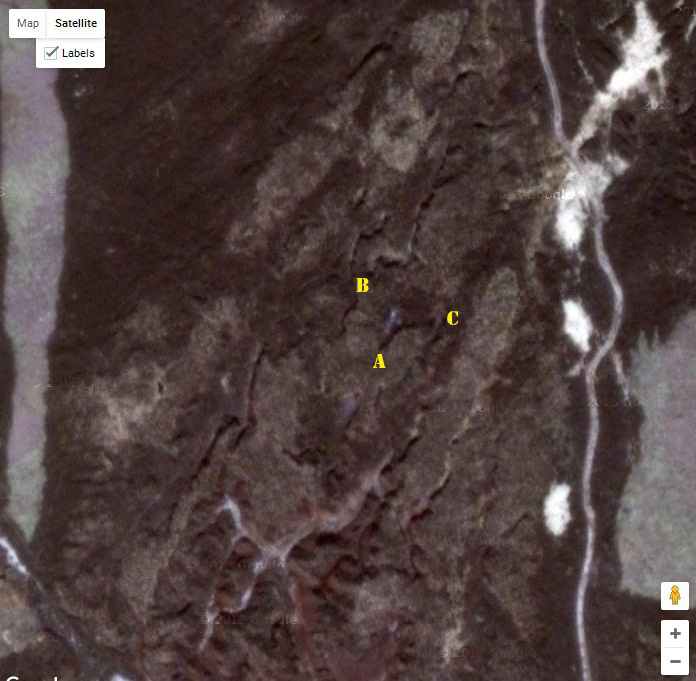
Google Earth image showing the scar, again with the same reference points added.
By following the direction the 'nose' of the scar was pointing I was able to follow a trail of fragments through the peat gullies and over to the other side of the baelach where I found an area where wreckage had been buried and a little further on an area where a section of the Vulcan must have burned out. There was also some quite large pieces sticking out of some of the peat hags, these were impossible to even budge giving the impression they were just the 'tip of the iceberg'.
These gullies on the baelach contained numerous fragments
in a trail leading towards Hill of Cat, seen in the distance.
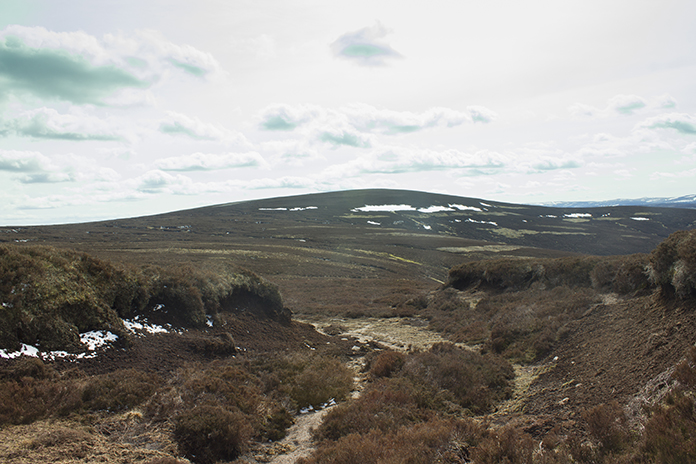 Photo taken in 2016
Photo taken in 2016
I took the photo above as I was emerging out of the peat gullies on the Hill of Cat side of the baelach, if I'd been about twenty feet back and stood on top of the peat hag it would have been a perfect match for the photo below which was taken in 1963 by Dennis Paterson a few days after the crash, before the wreckage had been cleared. I have added a yellow cross to the 1963 photo to show roughly where I was standing to take my photo.
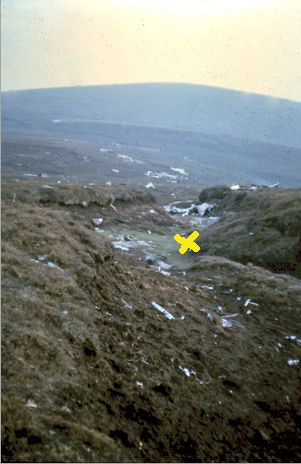
Photo taken in 1963
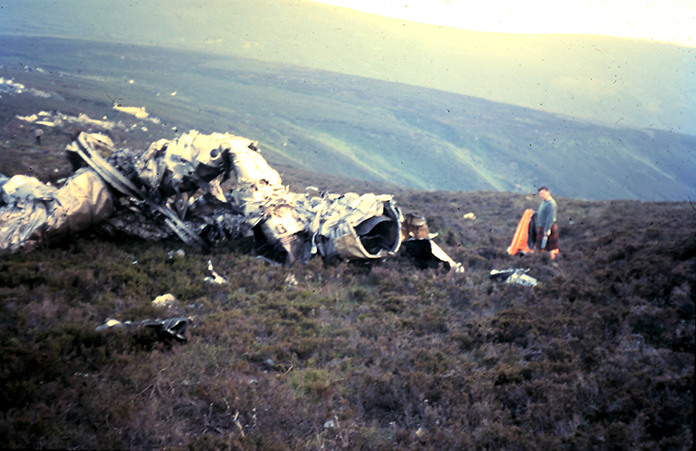
Above :-Sandy Buchan, 'Provost of Brechiin', holding a liferaft from the
Vulcan in 1963..
Below:-The same scene in 2016
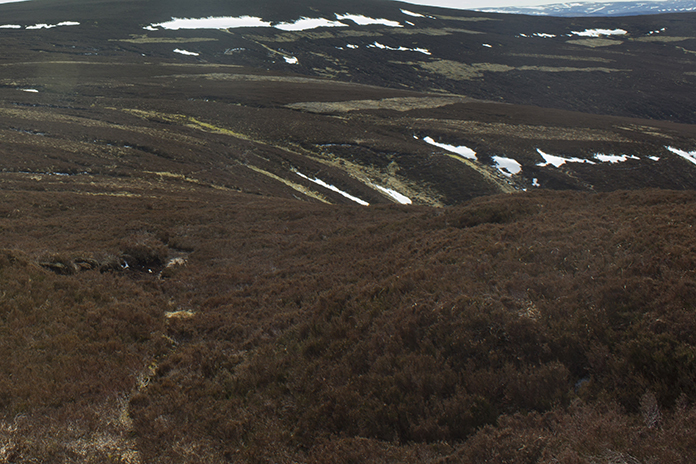
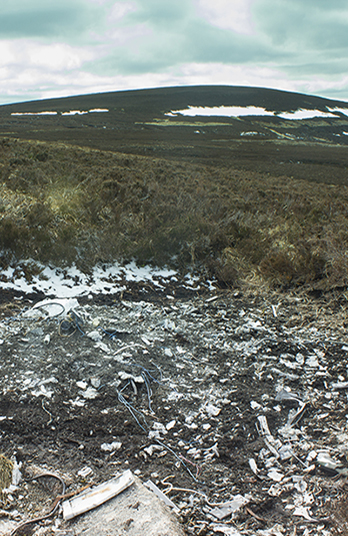
1963
2016
A scar containing small parts and melted alloy,
this is where the Vulcan's wing section burnt out.
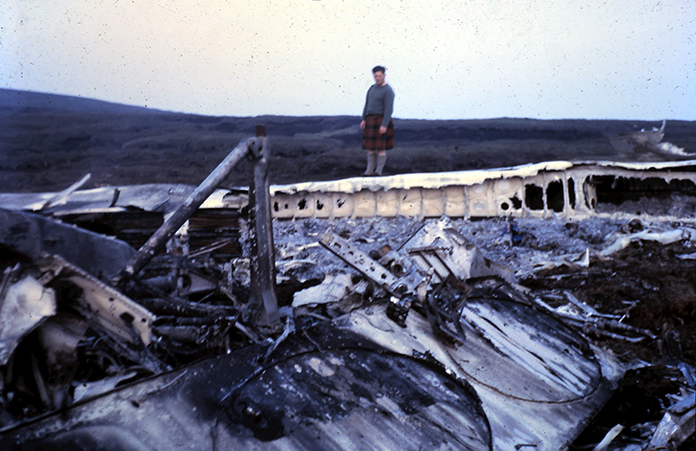
Above:-Sandy Buchan standing on the burnt out wing section in 1963.
Below:-The same scene in 2016..
The
same scar taken from the other side
Melted alloy and small pieces in the burn out scar.
Although I'd found quite a few pieces there was probably quite a few more I'd overlooked because it would of taken me far too long to check all the hollows and gullies in the area. There's probably a fair few chunks buried in the soft peat as well.
Quite substanial lump of spar sticking out the peat, it wouldn't budge
an inch.
A very 1960's lookin Pop bottle. Although
the bottom was broken the stopper was still in place and sealed suggesting
whover it belonged to didn't get to drink the contents before dropping it.
Hays was a local pop manufacturer based in Inverurie suggesting this
bottle was left by an early visitor to the site or by one of the recovery
crew.
On my way back towards Hill of St Colm I came across another area of wreckage which looked like it was a burial pit. There was definately stuff buried here but how deep down it went I couldn't tell, may have been 1ft may have been 20ft!
It looked like a lot of the smaller pieces left over after recovery may have been collected together and buried here.
Above and below:- A voltage regulator found on top of the burial pit.
Above and next 3 photos:-By lifting one of the panels lying on the surface I could see there was stuff buried at least a foot down, there may have been stuff buried a lot deeper.
Possibly a bit of fuselage frame.
A big heavy electrical componant
A small air intake or vent
There could possibly be parts buried in the whole of this scar
not just the exposed part at the front, it did appear that all the boulders had been chucked on the top
and there was fragments in amongst them.
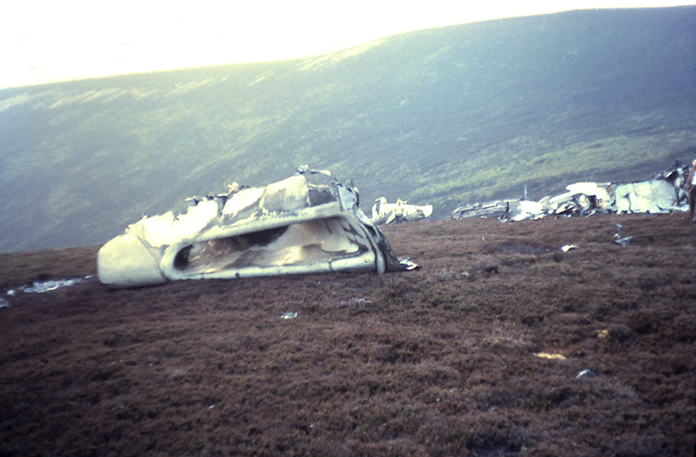
above and below:-Two more views of the same area of wreckage in 1963 above and in 2016 below. In the 2016 photo below I was standing nearer to the wreckage in the backgound when I took the photo, this is where the burial pit is located.
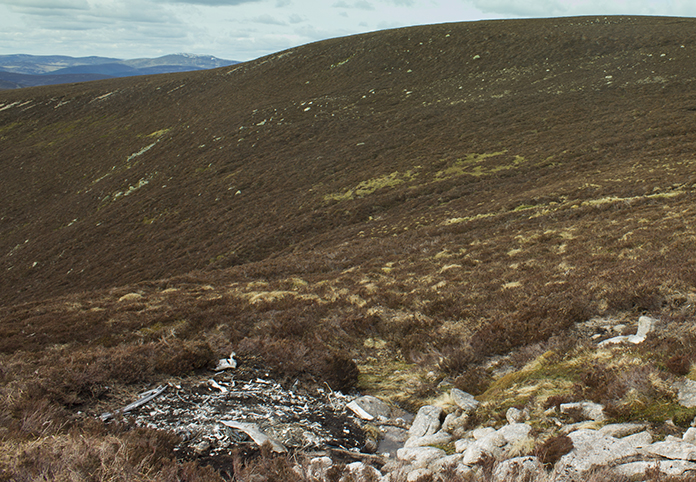
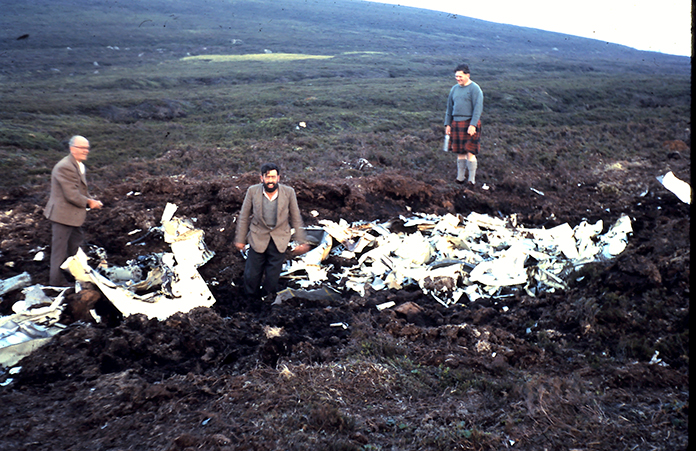
Above:-Local Farmer Alistair Skene(centre) and Sandy Buchan(right)
with a 3rd unknown person in 1963
Below:-The nearest match I had to the photo
above, same area but whereas the photo above was taken facing to the north
east, mine below was facing to the north.
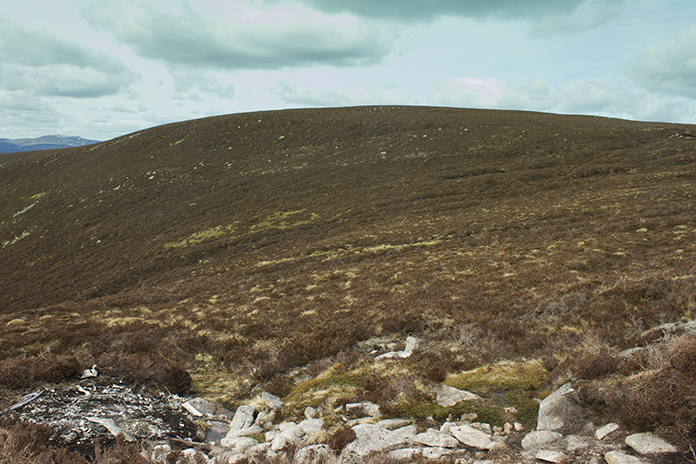
above and below:- I found two scars near to each other that were made by two of the vulcans engines. My photo above is almost an exact match for the one below taken in 1963 although I would say the photographer in 1963 had hunkered down to take the photo whereas I was standing up. Although both scars could be the one from the 1963 photo I believe it is this one as it's length and direction was more spot on then the other one.
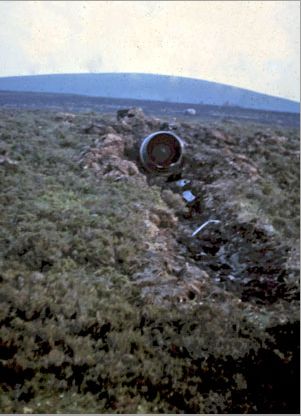
Above and below:-The other engine scar in the photo below could also possibly be the one shown above in 1963. Both scars can be seen below, the other one being about 20 feet in front and to the left of the one in the foreground.
above and below:-Turbine blades from the engines found in the two scars.
These larger turbine blades were found in the rocky area of the burial pit scar
and due to the obviously different corrosive properties they must be made
from a different metal to the smaller ones I found.
above and next 3 photos:-Large electronic device, this was a circular shaped componant about 20" in diameter, the domed shaped caps from each end were lying nearby. One cap had a small glass window in it. I have sent these photos to a couple of Vulcan preservation groups to see if they can identify what it is and one suggested it may be a gyroscope but they passed the photos on to their Boffins and I am waiting to hear back from them.
In February of 2018 I was contacted by Martin Parson Chief Technician 15(R) SQN-Eng Avionics who was based at Lossiemouth, Martin wanted to visit the Vickers Warwick crashsite in Culbin Forest and contacted me for help in locating it. I took the opportunity to ask him if he knew what the componant above was.
His reply:-
"As for your avionics component, I doubt it is the inertial platform due to the lack of anti-vibration mountings. What I did notice is that the components with the heavy oxidation look like wave guide components, the spy glass would also suggest the checking of a level, maybe coolant. This suggests it could be part of the Radar system. I found two possibilities, either the Modulator or the Amplifier.I could only find a few images, I hope it helps.
http://www.tatjavanvark.nl/tvve/viewer136.html items 32 and 35
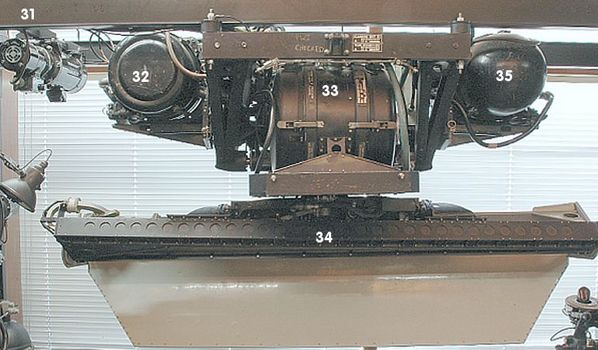
http://www.tatjavanvark.nl/tvve/viewer128.html from a different angle."
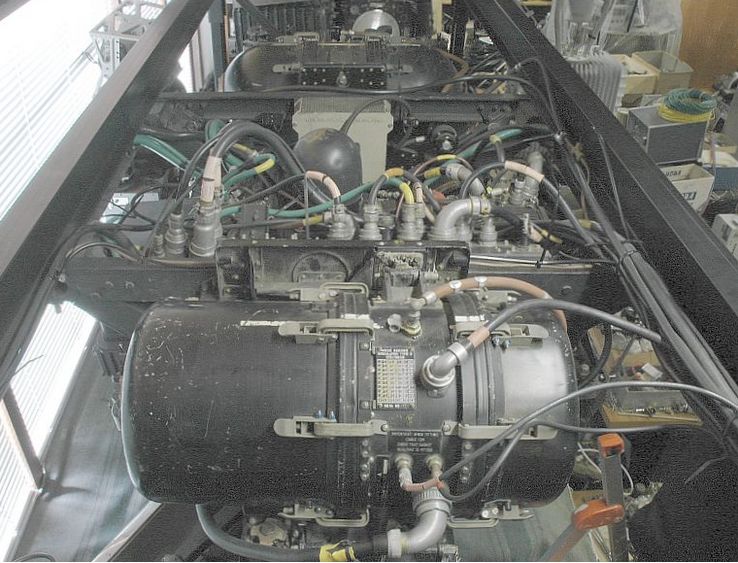
Another possible large piece sticking out the peat, again any attempt to budge it was unsuccessful suggesting there was a lot more of it buried than there was protruding.
It took me 1 hour 45 minutes to reach the Vulcan crashsite so I was
confident I would easily have time to go along to Peter Hill as well, but
then I spent way too much time finding all the pieces of the Vulcan that
were scattered around and taking photographs. My options now were:
1-All
but run down the Hill so I would still have just enough time left to go to
the F100 crashite.
2- Leave the F100 for another day, take my time and
enjoy the walk back to the car.
I chose the latter option as trying to run
down the steep section of the Landrover track would have proven just as
calamitous as trying to ride my bike down it. In fact when it came to
walking down it I still ended up on my arse a couple of times.
Hill of St Colm, I have added arrows to show the direction of the Vulcan as it
disintegrated, the yellow cross is where it initially hit the hill.
This crashsite proved to be very interesting especially the scar that so closely resembled the shape of the plane and although I was expecting to find just tiny fragments I ended up discovering quite a bit more. This is also the one and only crashsite that I have ever taken a souvenier from; although I believe taking souvenirs is a pointless exercise my souvenir was anything but pointless!
My Souvenir, not a tree root but a rather impressive Deer's Antler.
I had plans of varnishing it and making it into an ornament but my
enthusiasm was not matched by my wife, and our old Golden Retriever thought it
was a bone and kept stealing it. Our neighbour now has it with his plan
being to make into a lamp!
The aquisition of the Deer antler almost had dire conseqeunces after I secured it to the back of my rucksack. As I hit the afore mentioned steep section of the landrover track I lost my footing on the loose surface and promptly fell backwards. Usually my rucksack acts as a cushion when this happens but today I had a very pointy 'souvenir' attached to it. I was actually more worried that I had broken the antler than if it had impaled me in the back.
above and below:-On the way back past Birse Castle
Always a welcome sight no matter how enjoyable the walks been.
When I arrived back at the car I received a text to inform me the
Championships at Aberdeen were running well late so I contemplated still
having a go at Peter Hill, but it would have been a mad rush. Instead I
decided the sensible thing to do was head back to the Beach Ballroom in
Aberdeen and catch a couple of hours Zzzzz's which would put me in good
shape for the long drive home.
Yet again Heather finished my day off very
nicely when she emerged from the venue carrying the trophy she had
received for
finishing in 6th place in the line up. This meant she had maintained her
record of finishing in the line up for every Championships she had taken
part in so far this year.

All photos from 1963-Dennis Paterson/Cameron Paterson
